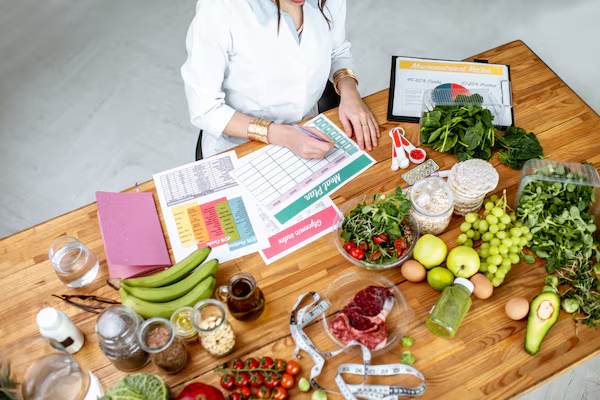Preparing meals ahead of time is one of the best ways to eat a healthy diet. Having prepared meals reduces the likelihood of impulsive decisions. Hunger always appears unexpectedly. Having prepared and portioned healthy meals ensures that you always have access to nutritious food. Whether you’re trying to lose weight, build muscle, or just feel better every day, prepping meals ahead of time can help you achieve your goals by making it easier to find healthy foods.
Benefits That Go Beyond Your Plate
Preparing meals ahead of time not only helps you eat healthier, it also saves you time, money, and stress. By cooking in batches, you only have to do the grocery shopping, cooking, and washing up a few times a week. This helps you stay within your budget because you don’t have to make last-minute trips to the grocery store for leftovers or fast food. Having ready-made meals in the fridge also means you have no excuse to skip a meal or grab quick and easy snacks. The peace of mind that comes from knowing your meals are planned and ready is a real bonus.
Start with an effective plan
If you’re new to meal prepping, don’t overcomplicate things. Start by planning meals for two or three days instead of a week. Start with foods that you enjoy and know how to make. Soups, stews, grain dishes, and roasted vegetables are all good choices that you can store and reheat. Breakfast, lunch, dinner, and some snacks should all be on your meal prep plan. This will help you stay organized and save you time.
Stick to your grocery list
Once you have your lunch plan, write down everything you need to buy. To speed up your grocery shopping, consider breaking it down into categories like fruits and vegetables, meats, grains, and kitchen supplies. A grocery list can help you stick to your plan and avoid buying unhealthy or useless foods. As you get better at planning ahead, you’ll know more quickly what to buy for a week of healthy meals.
Choose recipes that work well with the ingredients
Choose dishes that use the same ingredients but prepare them differently to save time and money. If you use sweet potatoes for grain dishes, you can also use them in breakfast casseroles or as a side dish for roast chicken. Adding spinach to drinks and lunch salads helps prevent food waste and makes several meals healthier. This keeps your meals fresh without having to buy too many different items.
Set aside time for prep days
Choose one or two days a week to cook and prepare ingredients. Many people choose Sunday because it’s a good way to start the week, but you can choose any day that suits you. Spend a few hours preparing as if you were attending an important meeting. During this time, cook grains, meats, and vegetables. Then, plate the food on appropriately sized plates. Please label the plates with the date or type of food to prevent any confusion later.
Choose the right storage containers
Choosing the right dishware is the first step to preparing good meals. Choose BPA-free, microwave-safe containers with airtight lids to keep food fresh. Glass dishware is worth investing in because it doesn’t stain or develop odors easily. Rotate your containers. Use small containers for single-serving portions and larger containers for items like rice, diced vegetables, or deli meats. Clear packaging also makes food easy to see, which reduces food waste.
Keep it simple and honest
Healthy eating doesn’t have to involve complicated ingredients or hard-to-follow recipes. A balanced meal should include fiber from fruits or vegetables, healthy fats, complex carbohydrates, and lean protein. A simple grain bowl containing rice, steamed vegetables, avocado, and grilled chicken will suffice. Overnight oats with chia seeds, nuts, and almond milk also make a delicious breakfast. Use low-salt herbs, spices, and sauces to keep the flavor fresh.
Safe Storage and Reheating
To keep food safe and fresh, you need to store it properly. Most cooked dishes will keep for three to five days in the refrigerator. If you are preparing for a week, freeze meals that you plan to eat later in the week to maintain quality and prevent spoilage. When reheating, make sure the internal temperature is safe. Preparing a microwave-safe container can make the process easier. To prevent bacteria from developing in food, do not leave it at room temperature for too long. Finish it off. Adding different sauces or toppings is another easy way to spice things up without too much work.
Prep healthy snacks and quick meals
Don’t forget to make some snacks to go with your main meals. In between meals, you can eat healthy snacks like fruit slices, raw nuts, Greek yogurt, or veggie sticks with hummus to keep you going throughout the day. Packing small meals in small containers or reusable bags can make it easier to stick to them, especially when you’re on the go. These foods are also great for curbing cravings and preventing overeating later in the day.
Reflect and change your strategy
Like any habit, meal planning gets easier over time. Review it each week to see what worked and what didn’t. Did you undercook or overcook? Were there any meals you didn’t like or things you threw away? Use what you’ve learned to improve your plan for the following week. Over time, you’ll find a meal prep method that works perfectly with your schedule. That way, healthy eating will come naturally, not forced.
Above all, stick to a routine to stay healthy
Preparing meals ahead of time isn’t just a trend; it’s a way to maintain your health in the long run. Planning, preparing, and scheduling your meals ahead of time takes the guesswork and stress out of making unhealthy food choices. It increases your likelihood of eating healthy, even on busy days, and reminds you of the importance of being healthy. Take a little time each week to eat more regularly. It’ll save you money and give you the peace of mind of knowing your meals are taken care of.




